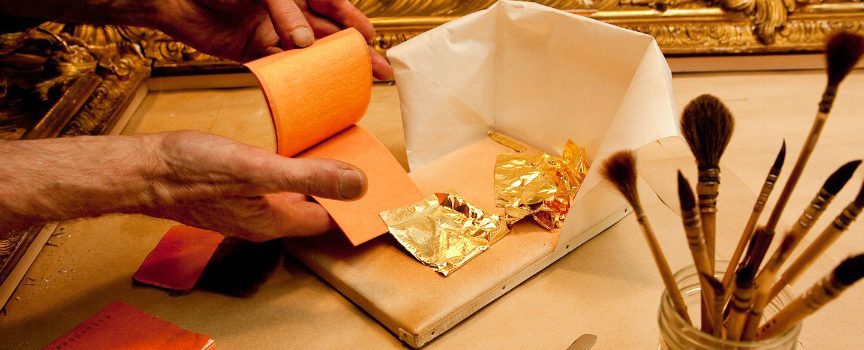Gold Leaf Gilding & Other Gilding Variants Part 1

Gilding is a term used to describe a variety of techniques used to to apply a thin layer of gold, either as leaf or in other forms, to the surface of various materials. A few of these materials that are often gilded include wood, stone, metal, glass and parchment. Gilding also refers to the application of other metals in the form of leaf or powder. Silver, platinum, palladium, brass, aluminum and copper are the most common. There are numerous methods of adhering the leaf to it’s substrate which include using various adhesives, combining the gold with chemicals and applying to the surface in a cold process or using heat to fuse the gold or other leaf to the surface. Electroplating and mercury or fire gilding are are other ways of producing a gilded surface but we will confine ourselves here to those methods most commonly used on a wood base such as for picture frames or art objects and architectural elements.
Herodotus, the 5th Century Greek historian writes of the ancient Egyptians gilding wood, metals and glass. Other cultures from antiquity also gilded funerary objects, statues. furniture and details in interior spaces. Any metal that is malleable and can be beaten into thin sheets can be used for gilding. Gold leaf is the most ductile in this regard and can be reduced to thickness that is semi-transparent when held up to the light. The ancient’s gold leaf was heavier than that produced today which is beaten to approximately 1/250,000th of an inch thick. Because it is so thin, it conforms perfectly to the surface it is laid upon, which if it is properly prepared, can give an object the impression of being made from solid gold.
The process of gilding on wood is essentially unchanged from ancient times but came into it’s ascendancy in the western world during the Renaissance. The same fundamental materials and methods used to apply the leaf would be the same whether on picture frames, wood statues or architectural embellishments such as seen in opulent interiors such as cathedrals and palaces.
Although many different procedures for gilding have been used over the centuries, there are essentially two traditional methods are used to produce a gilded wood surface. These are known as water gilding and oil or mordant gilding. These will be discussed in greater detail in another article.
Water gilding is most often done on a wood base properly prepared with several layers of gesso. Traditional gesso is a mixture of whiting (chalk) and an animal glue. At the consistency of heavy cream, enough coats are brushed on to fill the wood grain. The gesso is allowed to dry and then smoothed or shaped.
Next, on top of the gesso a layer of bole will be applied. Bole refers to special refined earth clays that come in colors such as red, yellow and gray. The bole is mixed with a glue such as rabbit skin glue and three or four coats are brushed on top of the gesso and allowed to dry.
To leaf this prepared surface, the bole is wet by brush with water and the leaf laid on the surface. The adhesive properties of the rabbit skin glue in the bole are re-activated with the water and the leaf adheres to the surface of the bole hence the term water gilding. Sometimes a second layer of leaf is laid over the first. This is called double gilding and produces an even finer more unbroken surface. The gold leaf can can then be burnished to a highly reflective sheen with an agate tipped burnishing tool or left unburnished with a matte finish for contrast.